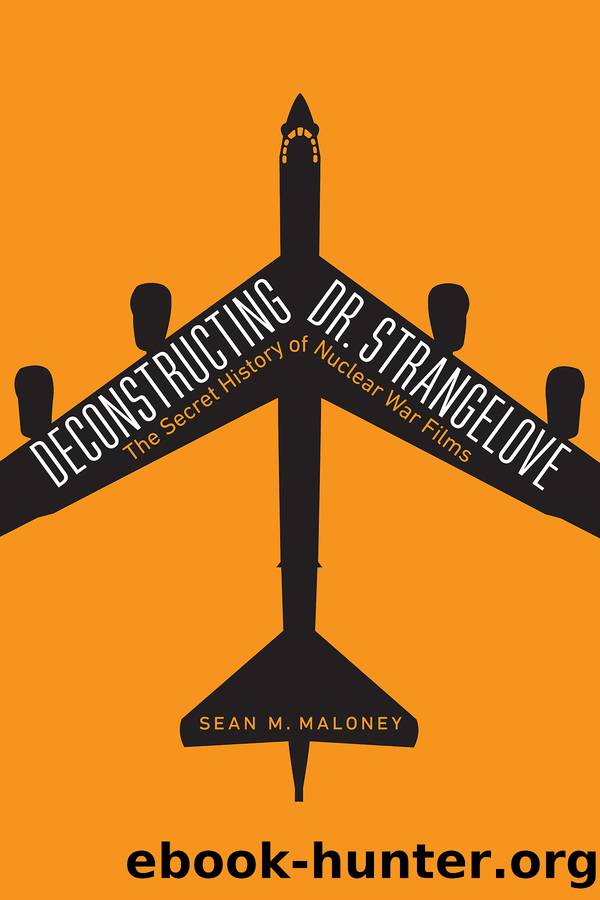Deconstructing Dr. Strangelove by Sean M. Maloney

Author:Sean M. Maloney [Maloney, Sean M.]
Language: eng
Format: epub
Tags: PER004030 Performing Arts / Film & Video / History & Criticism, HIS037070 History / Modern / 20th Century
Publisher: University of Nebraska Press
8
Strategic Underground Command
The ICBM Force in Film and History
ICBM. The intercontinental ballistic missile. No acronym is more closely associated with the Cold War than this. The technological extrapolations of Nazi-era terror weapons put to use as the cornerstones of the deterrent system, they bore mighty names (aspirations?): Atlas, Titan, Minuteman, Peacekeeper. Their opponents were Soviet missiles with code-names like Shyster and Satan. ICBMs harnessed the potential of the H-Bomb plus the ballistic missile plus speed of delivery, changing the strategic dimensions of the Cold War. Now a whole war could be conducted in an hour with unprecedented levels of destruction.
By 1965 that potential was fully realized. By the 1970s the drama of the bomber crew in Dr. Strangelove and Fail-Safe was replaced with a new type of drama in both WarGames and By Dawnâs Early Light: Do we fire or not fire? Oh, and we have less than thirty minutes to make a decision, not hours to negotiate over the Hot Line. This drama was augmented by connecting that anxiety with having the world-ending decision made with little or no human input. The logical extension of that system found expression in Dr. Strangelove, Colossus, and WarGames.
The stereotypical view of the ICBM goes like this: It is a big, dumb rocket that goes from A to B in thirty minutes, launched from an underground facility called a silo. Two guys (and later girls) out in a cornfield the middle of nowhere in a flyover state, probably one of the Dakotas, sit in a secure underground capsule, each with a key and connected to a communications system that tells them when to launch the missile, not why or at what. They carry pistols, which seems to be contradictory given the fact it takes two to launch the weapons. Morale patches for their uniforms are a must: one of them, playing on the quote about the Minuteman ICBMs being Americaâs âace in the hole,â has a skeletal hand holding playing cards full of mushrooms clouds: âPlay the hand youâre dealt.â (In another squadron it is, âWe play the last hand.â) The other wears a patch that asserts, âDeath wears fuzzy bunny slippersâ and depicts the Grim Reaper at a control panel with his scythe and nonregulation footwear. Gen. Thomas S. Power rotates in his grave because of the relaxation in SAC dress standards.
To those who served in the early ICBM units in the 1960s this was cutting-edge technology in an advanced career field working on a space launch vehicle, albeit one with a megaton-yield warhead.1 Atlas missile crews in a Kansas cornfield near Valley Falls were using the same system that NASA used at Cape Canaveral to put John Glenn and Gus Grissom in orbit.
To others the day-to-day operations of the capsule and its panels were humdrum compared to what bomber crews did: Herman Kahn apparently once suggested that the air force rename the ICBM units Strategic Underground Command; the derived acronym obviously did not go over well with the U.S. Air Force.
Download
This site does not store any files on its server. We only index and link to content provided by other sites. Please contact the content providers to delete copyright contents if any and email us, we'll remove relevant links or contents immediately.
Naked as Nature Intended by Pamela Green(415)
The Filmmaker's Guide to Creatively Embracing Limitations: Not Getting What You Want Leading to Creating What You Need (for True Epub) by Pace William & Stobbe Ingrid(412)
30 Movies to Get You Through the Holidays by Roger Ebert(388)
Bond, James Bond by Brad Gilmore(351)
It's Only a Movie! by Haberski Jr. Raymond J(320)
Chinese films in focus II by Unknown(280)
How To Write A Novel The Easy Way Using The Pulp Fiction Method To Write Better Novels: Writing Skills by Jim Driver(266)
The Fellowship of the Knits: Lord of the Rings: The Unofficial Knitting Book by Tanis Gray(264)
Smartphone Cinema: Making Great Films with Your Mobile Phone by Bart Weiss(264)
Film Truth; November, 1920 by Anonymous(259)
Charles McGraw by Alan K. Rode(255)
The Greatest Show on Earth by Jerry Pinto(253)
Thomas Mann and Friedrich Nietzsche: Eroticism, Death, Music, and Laughter by Caroline Joan Picart(230)
Jafar Panahi: Interviews by Unknown(229)
The Garden in the Machine by Unknown(229)
The Reel Truth by Reed Martin(229)
Jurassic Park and Philosophy by Watkins Jessica Michaud Nicolas(224)
The Japanese Cinema Book by Hideaki Fujiki & Alastair Phillips(219)
Euro-Visions: Europe in Contemporary Cinema by Mariana Liz(215)
